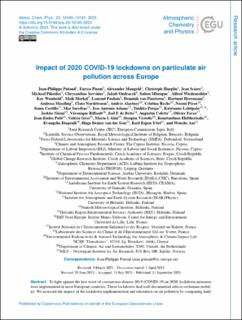| dc.contributor.author | Putaud, Jean-Philippe | |
| dc.contributor.author | Pisoni, Enrico | |
| dc.contributor.author | Mangold, Alexander | |
| dc.contributor.author | Hueglin, Christoph | |
| dc.contributor.author | Sciare, Jean | |
| dc.contributor.author | Pikridas, Michael | |
| dc.contributor.author | Savvides, Chrysantos | |
| dc.contributor.author | Ondráček, Jakub | |
| dc.contributor.author | Mbengue, Saliou | |
| dc.contributor.author | Wiedensohler, Alfred | |
| dc.contributor.author | Weinhold, Kay | |
| dc.contributor.author | Merkel, Maik | |
| dc.contributor.author | Poulain, Laurent | |
| dc.contributor.author | van Pinxteren, Dominik | |
| dc.contributor.author | Herrmann, Hartmut | |
| dc.contributor.author | Massling, Andreas | |
| dc.contributor.author | Nordstroem, Claus | |
| dc.contributor.author | Alastuey, Andres | |
| dc.contributor.author | Reche, Cristina | |
| dc.contributor.author | Perez, Noemi | |
| dc.contributor.author | Castillo, Sonia | |
| dc.contributor.author | Sorribas, Mar | |
| dc.contributor.author | Adame, Jose A. | |
| dc.contributor.author | Petäjä, Tuukka | |
| dc.contributor.author | Lehtipalo, Katrianne | |
| dc.contributor.author | Niemi, Jarkko | |
| dc.contributor.author | Riffault, Véronique | |
| dc.contributor.author | De Brito, Joel F. | |
| dc.contributor.author | Colette, Augustin | |
| dc.contributor.author | Favez, Olivier | |
| dc.contributor.author | Petit, Jean-Eudes | |
| dc.contributor.author | Gros, Valérie | |
| dc.contributor.author | Gini, Maria | |
| dc.contributor.author | Vratolis, Stergios | |
| dc.contributor.author | Eleftheriadis, Konstantinos | |
| dc.contributor.author | Diapouli, Evangelia | |
| dc.contributor.author | van der Gon, Hugo Denier | |
| dc.contributor.author | Yttri, Karl Espen | |
| dc.contributor.author | Aas, Wenche | |
| dc.date.accessioned | 2023-09-19T10:00:15Z | |
| dc.date.available | 2023-09-19T10:00:15Z | |
| dc.date.created | 2023-09-18T08:54:59Z | |
| dc.date.issued | 2023 | |
| dc.identifier.citation | Atmospheric Chemistry and Physics (ACP). 2023, 23, 10145-10161. | en_US |
| dc.identifier.issn | 1680-7316 | |
| dc.identifier.uri | https://hdl.handle.net/11250/3090368 | |
| dc.description.abstract | To fight against the first wave of coronavirus disease 2019 (COVID-19) in 2020, lockdown measures were implemented in most European countries. These lockdowns had well-documented effects on human mobility. We assessed the impact of the lockdown implementation and relaxation on air pollution by comparing daily particulate matter (PM), nitrogen dioxide (NO2) and ozone (O3) concentrations, as well as particle number size distributions (PNSDs) and particle light absorption coefficient in situ measurement data, with values that would have been expected if no COVID-19 epidemic had occurred at 28 sites across Europe for the period 17 February–31 May 2020. Expected PM, NO2 and O3 concentrations were calculated from the 2020 Copernicus Atmosphere Monitoring Service (CAMS) ensemble forecasts, combined with 2019 CAMS ensemble forecasts and measurement data. On average, lockdown implementations did not lead to a decrease in PM2.5 mass concentrations at urban sites, while relaxations resulted in a +26 ± 21 % rebound. The impacts of lockdown implementation and relaxation on NO2 concentrations were more consistent (−29 ± 17 and +31 ± 30 %, respectively). The implementation of the lockdown measures also induced statistically significant increases in O3 concentrations at half of all sites (+13 % on average). An enhanced oxidising capacity of the atmosphere could have boosted the production of secondary aerosol at those places. By comparison with 2017–2019 measurement data, a significant change in the relative contributions of wood and fossil fuel burning to the concentration of black carbon during the lockdown was detected at 7 out of 14 sites. The contribution of particles smaller than 70 nm to the total number of particles significantly also changed at most of the urban sites, with a mean decrease of −7 ± 5 % coinciding with the lockdown implementation. Our study shows that the response of PM2.5 and PM10 mass concentrations to lockdown measures was not systematic at various sites across Europe for multiple reasons, the relationship between road traffic intensity and particulate air pollution being more complex than expected. | en_US |
| dc.language.iso | eng | en_US |
| dc.rights | Navngivelse 4.0 Internasjonal | * |
| dc.rights.uri | http://creativecommons.org/licenses/by/4.0/deed.no | * |
| dc.title | Impact of 2020 COVID-19 lockdowns on particulate air pollution across Europe | en_US |
| dc.title.alternative | Impact of 2020 COVID-19 lockdowns on particulate air pollution across Europe | en_US |
| dc.type | Peer reviewed | en_US |
| dc.type | Journal article | en_US |
| dc.description.version | publishedVersion | en_US |
| dc.rights.holder | © Author(s) 2023. | en_US |
| dc.source.pagenumber | 10145-10161 | en_US |
| dc.source.volume | 23 | en_US |
| dc.source.journal | Atmospheric Chemistry and Physics (ACP) | en_US |
| dc.identifier.doi | 10.5194/acp-23-10145-2023 | |
| dc.identifier.cristin | 2175876 | |
| dc.relation.project | NILU - Norsk institutt for luftforskning: 121002 | en_US |
| dc.relation.project | NILU - Norsk institutt for luftforskning: 7726 | en_US |
| dc.relation.project | EC/H2020/654109 | en_US |
| dc.relation.project | EC/H2020/871115 | en_US |
| dc.relation.project | NILU - Norsk institutt for luftforskning: 118007 | en_US |
| cristin.ispublished | true | |
| cristin.fulltext | original | |
| cristin.qualitycode | 2 | |

